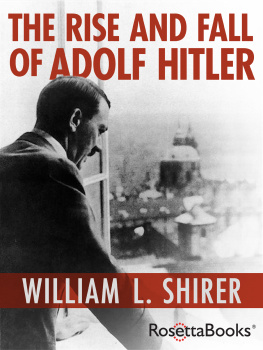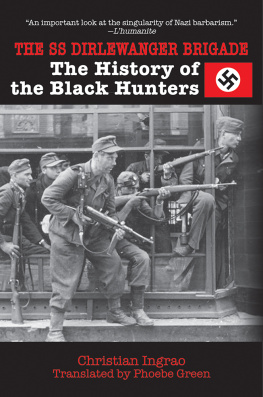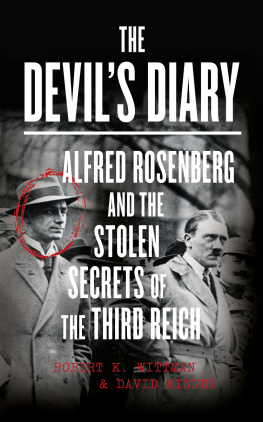Believe and Destroy
For Guido Fanti
This work has been published under the
direction of Anthony Rowley.
Believe and Destroy
Intellectuals in the SS War Machine
By Christian Ingrao
Translated by Andrew Brown
polity
First published in French as Croire et dtruire Editions Fayard, 2010
This English edition Polity Press, 2013
Polity Press
65 Bridge Street
Cambridge CB2 1UR, UK
Polity Press
350 Main Street
Malden, MA 02148, USA
All rights reserved. Except for the quotation of short passages for the purpose of criticism and review, no part of this publication may be reproduced, stored in a retrieval system, or transmitted, in any form or by any means, electronic, mechanical, photocopying, recording or otherwise, without the prior permission of the publisher.
ISBN-13: 978-0-7456-7005-8
A catalogue record for this book is available from the British Library.
The publisher has used its best endeavours to ensure that the URLs for external websites referred to in this book are correct and active at the time of going to press. However, the publisher has no responsibility for the websites and can make no guarantee that a site will remain live or that the content is or will remain appropriate.
Every effort has been made to trace all copyright holders, but if any have been inadvertently overlooked the publisher will be pleased to include any necessary credits in any subsequent reprint or edition.
For further information on Polity, visit our website: www.politybooks.com
Contents
Preface
Being a French historian of Nazism, trained in historical studies by the proponents of a cultural history of belief and violence, has played a major role in my choice of analytical tools. Ever since the mid-1980s, a group of historians has addressed itself to reinterpreting the history of the great and decisive conflagration that broke out at the beginning of the twentieth century. This group is international, interdisciplinary and interested in the most varied sources, especially the world of material objects produced by European societies during the Great War, held in the collections of the Historial de la Grande Guerre (Museum of the Great War) in Pronne. The group includes historians such as Jean-Jacques and Annette Becker, Gerd Krumeich, John Horne and Jay Winter, who, with their colleagues, have played a considerable role in the shaping of the conceptual tools that have guided the present work.
The key role was played by Stphane Audoin-Rouzeau. Through his work on cultures of violence, on the world of children at war,
I also explored other horizons. The history of the great religious struggles of the medieval and modern periods, and my reading of Alphonse Dupront and, especially, Denis Crouzet, seemed to suggest that there was another way of approaching the question of belief, as well as violence, and that the utterances of the actors in these movements, far from being empty chatter, a mere by-product of sociological mechanisms inaccessible to the actors themselves, comprised a way of getting into their representations. My starting point lay in grasping Nazism as a system of beliefs shaped into specific discourses and practices, one that of course emerged also from a machinery of public policies produced by peoples impulses and decisions, but on a deeper level was infused by emotions of a different order from those grasped by the political sciences or sociology disciplines which, governed for twenty years by the functionalist paradigm, had formed the basic conceptual resources of German historiography. These tools, after all, had not been able to tackle fervour or anxiety, suicide or cruelty, utopia, despair or hatred, or kindred emotions.
There was perhaps no great originality in these methodological choices: other French specialists in the human sciences also opted for alternative approaches and produced interesting work in the mid-1990s. douard Conte and Cornelia Essner published La Qute de la race. Une anthropologie du nazisme (The Quest for Race. An Anthropology of Nazism), which invited us to pick up tools from structuralist social anthropology and apply them to studies of Nazism. Working on images and representations of lineage, on marriage, racial beliefs, funerary rituals and practices of colonization, Conte and Essner showed the benefits of a study that brought together ideological discourses, political decisions and concrete behaviour. And, between the lines, they also worked out a critique of the exaggerated functionalism of German historians.
But the essential interest of the men studied here is that they simultaneously produced a doctrinal discourse that made it possible for me to analyse their system of beliefs in detail, and carried out to their conclusion, at ground level, the practical consequences of this system of beliefs once they assumed command of the Einsatzgruppen that exterminated the Jews of Russia in the occupied territories Crimea, Ukraine, Belorussia, Russia and the former Baltic States. Thanks to the work of Denis Crouzet, I have been able to sketch out a decisive reinterpretation of Nazi practices of violence. In Les Guerriers de Dieu (Gods Warriors), he postulated that a system of gestures (gestuelle) of violence was itself a language reflecting Hence my decision to take modes of investigation from social anthropology and apply them to the history of Nazism. It is under these auspices, and equipped with these tools, that the present work has been written, following three main guidelines.
My initial ambition was to retrace what the German historian Gerd Krumeich called an Erfahrungsgeschichte, a history of the actual experience of these men, so as to understand how the framework of their lives might have shaped their system of representations. This is where I was able to profit most fully from the heritage of the historians of the Great War: I tried to study childrens wartime lives as a crucial experience, scarred by a collective narcissistic wound that was interpreted in apocalyptic and eschatological terms.








